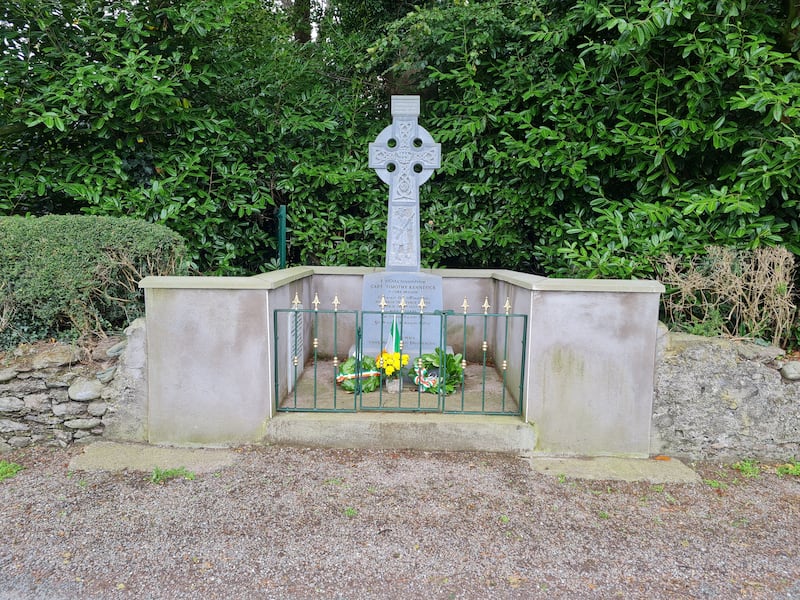The execution of an unarmed anti-Treaty IRA officer who was dragged from a truck on the way to his mother’s funeral, bludgeoned with rifle butts, and shot by Free State troops 100 years ago, ranks as one of the “worst of the unofficial killings” of the Civil War, according to a leading historian.
Dr Andy Bielenberg, of the School of History at University College Cork, said the killing of Capt Tadhg (Timothy) Kennefick (29) by Free State troops near Coachford in Mid-Cork on September 8th, 1922, was comparable to some of the worst atrocities carried out by Free State troops in Co Kerry.
“There were official executions carried out by the provisional government and then there were the unofficial executions — some people called them ‘roadside killings’ where men were killed by Free State forces while in custody, and Kennefick is one of the worst of those,” he said.
“It certainly would be comparable to the ones that took place later in Co Kerry at Ballyseedy and Countess Bridge near Killarney and Bahaghs near Cahersiveen where Free State troops used landmines and shot anti-Treaty IRA prisoners — they were all basically atrocities of one kind or another.”
READ MORE
Dr Bielenberg said that Kennefick, a native of Blackpool in Cork City, joined the Irish Volunteers in 1917 and fought in the War of Independence but took the anti-Treaty side in the Civil War, and in 1922 was serving as a signaller with the No 5 Cork IRA Brigade under Ted Sullivan in West Cork.
He was billeted in Ballingeary in Mid-Cork when he received word that his mother had died in Cork City. He was travelling unarmed back to the city for the funeral when he was apprehended by a party of 30 Free State troops just outside Coachford on the morning of September 8th, 1922.
Much of the detail of what happened to Kennefick emerged at an inquest held three days later by Cork county coroner John J Horgan, and it was local man Pat Twomey from Rylane, a member of the Tadhg Kennefick Commemoration Committee, who uncovered the transcripts of the inquest.

According to eyewitness C Herlihy from Ballingeary, he was giving Kennefick a lift in his lorry to Cork when it broke down at Peake and they both got a lift from another man, Seamus Cotter, in his lorry, only for them to be stopped by Free State troops at Myshall near Dripsey.
“In one of the military lorries, the deceased recognised three or four of the Free State soldiers. He turned to me and said, ‘I’m done [for] as these know me.’ I was about six or eight yards from these men. They called him back, not by name. I next saw him walk along the road as if a prisoner and do not know what became of him. I never saw him alive again,” Herlihy told the inquest in Coachford on September 11th.
Witness W O’Leary told how he had heard Free State troops had taken a prisoner from the village and returned some time later without him, so he joined a search party and they travelled towards Rooves Bridge at Nadrid where they found the body of Kennefick dumped in a field.
“Two or three others looked at the condition of the body, which appeared to be dead. He was lying on his left side, his head was all battered, his face was all blood, and his clothes were disarranged as if he had been searched again and his hat was thrown on the ground beside him.”
Dr W O’Riordan of Peake told the inquest how he was called on the evening of Friday September 8th to go to the scene, where he examined the body of Kennefick and said he believed that he had been dead for between two and 10 hours.
“I saw the face all battered and made an examination. Shock and haemorrhage due to laceration caused by bullet wounds in the head, one an entrance wound over the right eye and an exit wound in the left temple, several marks on the face and two teeth broken,” he told the inquest.
Coroner John J Horgan wasn’t one to shy away from controversy when it came to inquest verdicts, having presided some seven years earlier over an inquest into the deaths of those who drowned aboard the HMS Lusitania when it was torpedoed by a German U-boat off the Cork coast in 1915.
On that occasion, the jury returned a verdict of “wilful and wholesale murder” against the officers of U-boat 20 and the empire and government of Germany, and the jury in the inquest into the death of Kennefick were equally direct and damning when it came to delivering their verdict.
The jury found that Kennefick was “wilfully murdered” by a party of Free State troops, and they brought in “a verdict of wilful murder against the officer in charge of the Free State troops in Coachford on the morning in question, and Richard Mulcahy as minister for defence”.
News of Kennefick’s killing spread quickly, with anti-Treaty IRA chief of staff Liam Lynch writing to fellow republican leader Ernie O’Malley and telling him of the “most brutal murder” of Kennefick which, he alleged, was carried out on the orders of Maj Gen Emmet Dalton.
According to a republican source, Kennefick received an horrific death under the orders of Dalton, who “had him dragged behind the back of a Free State truck while his hands were tied together” before he was beaten with rifle butts in the face and eventually shot.
Kennefick’s killing was raised in the Dáil by Mid-Cork Labour TD Thomas Nagle, pointing out that a verdict of “wilful murder” had been recorded against National Army troops and asking if any attempts had been made to bring the guilty soldiers to justice.
Minister for defence Richard Mulcahy sought to play down the jury’s verdict, telling Nagle that he had ascertained that “the inquest was held under the auspices of Irregulars, armed to the teeth and before a jury that was apparently selected by Irregulars”.
“The coroner, in directing the jury, pointed out that they had heard only one side of the case. This was inevitable under the conditions. An adjournment was suggested but not agreed to. Under the circumstances, no action has been taken to bring the so-called guilty troops to justice,” he added.
Dalton placed a notice in the Cork press soon afterwards, stating that “owing to the acts of terrorism to the civil population, and more particularly jurors, no inquests are to be held in future in the county unless written authority for the holding of same shall have been first given by him [Dalton].”
Emmet Dalton’s biographer Sean Boyne discussed the issue in his 2014 study of Dalton and said that “one of the witnesses at the inquest had claimed that the Free State convoy that captured Kennefick was commanded by Dalton but this was not corroborated and has to be treated with caution”.
According to Dr Bielenberg who, with emeritus professor James J Donnelly jnr of Wisconsin, has compiled a Cork Fatality Register 1919-1923 as part of the Irish Revolution project at UCC, Capt Kennefick’s killing stands out for the level of brutality involved.
“There were very few official executions in Cork during the Civil War but there were a lot more of these types of unofficial roadside executions. It was claimed by the Free State in the press that Kennefick was shot trying to escape but that is just not credible,” he said.
“I would say it was one of the worst of the unofficial killings — it wasn’t just that he was reportedly dragged behind a lorry, there were so many factors. It was vengeful and unnecessary — to shoot him was one thing but to subject him to such a savage death, it was so horrific it stands out.”
According to the Civil War Fatality Register compiled by Dr Bielenberg and Prof Donnelly, Kennefick was one of 236 people — comprising 114 National Army members, 52 anti-Treaty IRA members, one Cumann na mBán member, one British soldier and 62 civilians — to die in the Civil War in Cork between 1922 and 1923.

In 1930, Captain Kennefick’s widow applied under the Army Pensions Act for a pension as a dependent of her late husband and she was awarded a pension of some seven pounds a year arising from her husband’s service during the revolutionary period.
But questions remained unanswered and in 2005, Kennefick’s daughter Kathleen, then aged 85, wrote to the Tadhg Kennefick Commemoration Committee to thank them for honouring her father before asking for an explanation and apology from those responsible for his death.
“As growing children, we could always understand the cause for which he fought but could never understand the reason or the manner of his death. I am sure that even at this stage, it would be a great tribute to my father and his comrades if the relevant authorities were to issue an explanation and apology for his brutal murder.”
The Tadhg Kennefick Commemoration Committee will remember Kennefick with a wreath-laying ceremony at the monument near Rooves Bridge in Coachford at 3pm on Sunday.












